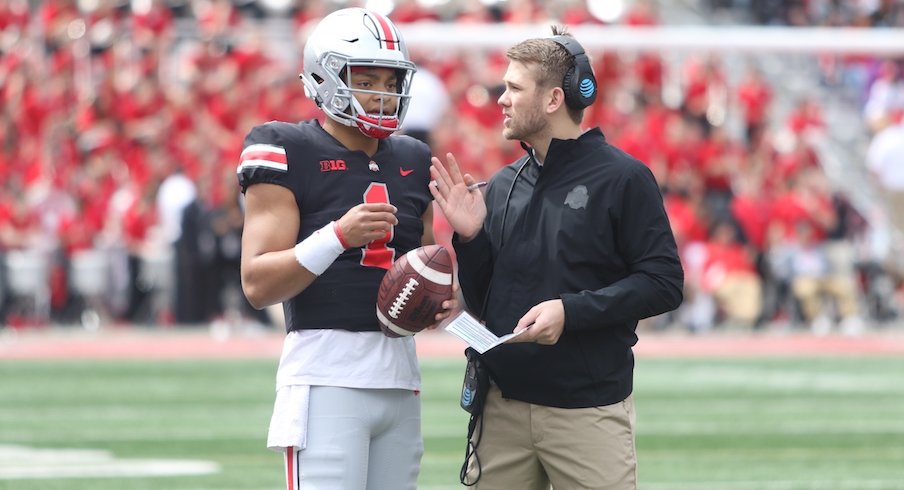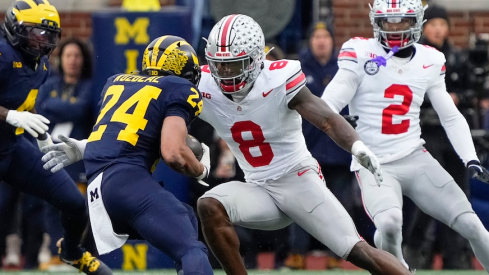When Ryan Day was asked on National Signing Day in February for his opinion on the increase of transfers in college football, Ohio State’s new head coach said he would be in favor of limiting teams to bringing in just two scholarship transfers per calendar year.
At the time, Ohio State was only anticipating two transfer additions this offseason – quarterback Justin Fields from Georgia and offensive lineman Jonah Jackson from Rutgers – and had only lost two players to transfers, Tate Martell (Miami) and Keandre Jones (Maryland). Day also said on that day that the Buckeyes would continue to make recruiting players out of high school their priority and that they would be “very, very careful” about adding transfers, only doing so when they identify “a great fit” at a position of need.
That, however, was before Matthew Baldwin made the decision just days after the spring game to transfer from Ohio State (eventually landing at TCU). That left the Buckeyes with a major need for another scholarship quarterback, and necessitated the addition of another transfer – Gunnar Hoak from Kentucky – to fill that hole. Redshirt freshman wide receiver L’Christian “Blue” Smith also left the team during spring practice before ultimately transferring to Cincinnati.
So when Day was asked during his press conference last week whether he still believed there should be a two-transfer-per-year cap, he acknowledged that his perspective had changed over the last four months.
“What I’ve found is that it’s a complicated issue,” Day said. “I think it’s easy for me to have ideas, but there’s a lot more to it than that. And that’s being at the Big Ten meetings and having those conversations with coaches, commissioners, administrators, I realize that there’s some complexity to it, and there’s no easy answer.”
While the transfers Ohio State brought in have the potential to be a huge net positive for the Buckeyes, as Fields is expected to be an upgrade at quarterback and Jackson is expected to provide veteran leadership to the offensive line at left guard, Day has concerns about how the increase in transfers throughout college football – spurred in part by the opening of the NCAA’s transfer portal last year – could impact the sport long-term.
Day understands, though, that it’s a complex issue with no simple solution.
“There are parts of it that I completely understand. There are other parts that make me very, very nervous about where the future of college football is going with it,” Day said. “But there's not an easy answer.”
The spike in transfers has been particularly profound at the quarterback position, and there’s no better example of that in college football right now than Ohio State, whose entire roster of scholarship quarterbacks – Fields, Hoak and Chris Chugunov (West Virginia) – transferred in from other schools. The Buckeyes lost Joe Burrow to a graduate transfer to LSU last offseason before losing Baldwin and Martell this offseason, leaving them in the position of needing to completely rebuild their roster after Dwayne Haskins entered this year’s NFL draft with two remaining seasons of eligibility.
Ohio State’s coaches understand that trend probably isn’t going to stop anytime soon. Because the starting quarterback is typically the only quarterback on a football team that sees regular playing time, backup quarterbacks are often inclined to transfer in search of starting opportunities – especially if there is no clear-cut future path to the starting job – and that’s been a reality since long before there was a transfer portal.
“I’m a guy who transferred myself,” said Ohio State quarterbacks coach and passing game coordinator Mike Yurcich, who began his collegiate playing career at Mount Union before transferring to California University of Pennsylvania. “I was a quarterback. It’s come full circle. I get it. I think you have to give yourself a chance. Most teams are only going to play one quarterback and that’s just the nature of competition.”
No matter who the Buckeyes recruit at quarterback going forward, that’s likely a reality they’ll have to deal with. In general, though, Day and his assistant coaches believe the best way to keep transfers to a minimum is to be honest with players during the recruiting process, find players who want to compete and foster a culture at Ohio State that makes players want to stay.
“I think that it's forcing coaches to be very clear in their communication of what the expectations are once they get here, and then doing a great job of communication once they're here,” Day said. “When you're recruiting somebody, you’re trying to show them all the positives about your school. But you also need to talk to them about every place has pluses and minuses, so that they understand those things when they get here. So that the minute something doesn't go well, they're not on the first train out of here.”
“There are parts of it that I completely understand. There are other parts that make me very, very nervous about where the future of college football is going with it.”– Ryan Day on the increase of transfers in college football
In the business of competing for championships, Ohio State’s coaches know they won’t be able to keep everyone happy with their role on the team, which means transfers will happen. They’re not going to change the way they coach players simply to try to keep them from transferring.
“I try not to think about it,” said co-defensive coordinator and secondary coach Jeff Hafley. “You try to coach everybody as hard as you can. You try to be fair to everybody the best you can. You can’t treat them all the same. You try to be there for them and hope you have a great relationship. You try not to think about it because I’m not going to coach scared or be afraid to coach hard.”
Outside of the quarterback position, though, Ohio State has lost only two other scholarship players to transfers this offseason (not including former running back Brian Snead, who was dismissed from the university before the end of last season). Considering that this offseason came with the departure of legendary head coach Urban Meyer and four of his assistant coaches from last year, Day and the Buckeyes have done an admirable job of keeping players in the fold so far.
“I'm very, very proud of what we've done here when you look at our numbers,” Day said. “We’re as good if not better than everybody else in the country in terms of this situation you're talking about. I think our culture is really, really good. I think the communication’s good. I think our families and their parents and the type of kids that we're recruiting all matter to that. And then having the Ohio base is critical too.”


